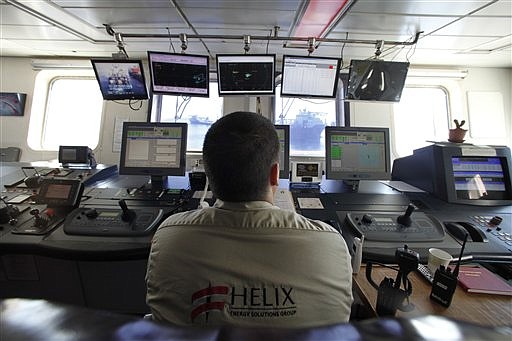NEW ORLEANS - In the end, it was a crush of mud that finally plugged the blown-out well in the Gulf of Mexico, three months after the offshore drilling rig explosion that unleashed a gusher of oil and a summer of misery along the Gulf Coast.
The government stopped just short of pronouncing the well dead, cautioning that cement and mud must still be pumped in from the bottom to seal it off for good.
President Barack Obama declared that the battle to contain one of the world's worst oil spills is "finally close to coming to an end."
Yet after months of living with lost income, fouled shorelines and dying wildlife, some Gulf Coast residents weren't so sure.
"I don't think we've finished with this," said 59-year-old Harry "Cho-cho" Cheramie, who grew up in Grand Isle, La. "We haven't really started to deal with it yet. We don't know what effect it's going to have on our seafood in the long run."
Still, it appeared there might finally be an end in sight to the disaster that closed vast stretches of fishing areas, interrupted the usually lucrative tourist season, and cost BP's CEO his job and the company's shareholders billions of dollars.
BP PLC said 2,300 barrels of mud forced down the well overnight had pushed the crude back down to its source for the first time since the Deepwater Horizon rig exploded off Louisiana on April 20, killing 11 workers and sending tar balls washing onto beaches and oil oozing into delicate coastal marshes.
And there was more seemingly good news: A National Oceanic and Atmospheric Administration report released Wednesday claimed that only about a quarter of the spilled oil remains in the Gulf and is degrading quickly. The rest has been contained or cleaned up or otherwise disappeared, and the report also said the oil no longer poses a threat to the Florida Keys or the East Coast.
NOAA said nearly 70 percent of the oil from the well dissolved naturally, or was burned, skimmed, dispersed and captured. But independent experts say it's an overly optimistic assessment and that the report contains more spin than science.
But the containment effort - and the cleanup - aren't finished. Crews that forced in the mud for the "static kill" now must decide whether to follow up by pumping cement down the broken wellhead. Federal officials said they won't declare complete victory until they pump in mud and cement from the bottom to seal the well, a procedure that might not be done for weeks.
"We're in a good place today, but we want to get it permanent over the near term, whether that's days or weeks," said Kent Wells, BP senior vice president, who repeatedly and pointedly avoided saying the static kill had finished the job. Asked when he will be able to say the well is dead, he replied: "I'm looking forward to that day."
An experimental cap had stopped the oil from flowing for the past three weeks, but it was not a permanent solution. Before it was lowered, the government estimates that 172 million gallons of oil had flowed into the Gulf.
And before that, BP tried a series of often-absurd sounding contraptions, raising hopes only to dash them when those efforts failed. They included a giant 100-ton containment box that got clogged with ice-like crystals and the so-called junk shot, an attempt to clog up the well with golf balls and rubber scraps.
The apparent success of the static kill had some along the Gulf curious about why BP waited so long to try it.
"I'm wondering, as smart as the people in the U.S. government are, they couldn't have done this sooner?" asked 78-year-old Willie Jones, a retiree from Baton Rouge, La., who sat in the shade in Pensacola Beach, Fla., while his wife and granddaughter ventured onto the white - and oil free - sand.
But the static kill - also known as bullheading - probably would not have worked without the cap in place. It involved slowly pumping the mud from a ship down lines running to the top of the ruptured well a mile below, and a similar effort failed in May when the mud couldn't overcome the flow of oil.
Workers stopped pumping mud in after about eight hours of static kill work and were monitoring the well to ensure it remained stable, BP said. Everything appeared to be going well Wednesday afternoon.
Charter boat captain Randy Boggs, of Orange Beach, Ala., said he has a hard time believing BP's claims of success with the static kill and similarly dismissed the idea that only a quarter of the oil remains in the Gulf.
"There are still boats out there every day working, finding turtles with oil on them and seeing grass lines with oil in it," said Boggs, 45. "Certainly all the oil isn't accounted for. There are millions of pounds of tar balls and oil on the bottom."
In the fishing town of Yscloskey, La., crabber Oliver Rudesill, 28, said he has been out of business like most of his buddies, some of whom are doing cleanup for BP instead but are earning about a quarter of what they do fishing.
"As soon as BP gets this oil out of sight, they'll get it out of mind, and we'll be left to deal with it alone," he said Tuesday.
Even politicians expressed concern that BP and the federal government will need to stay focused on the cleanup and long-term monitoring of the Gulf's marine life.
"This is a positive step," said Louisiana Gov. Bobby Jindal, "But this crisis is not over for Louisiana until the well is permanently capped and our coasts and wetlands are fully restored to their pre-spill status and our people can resume their way of life."
